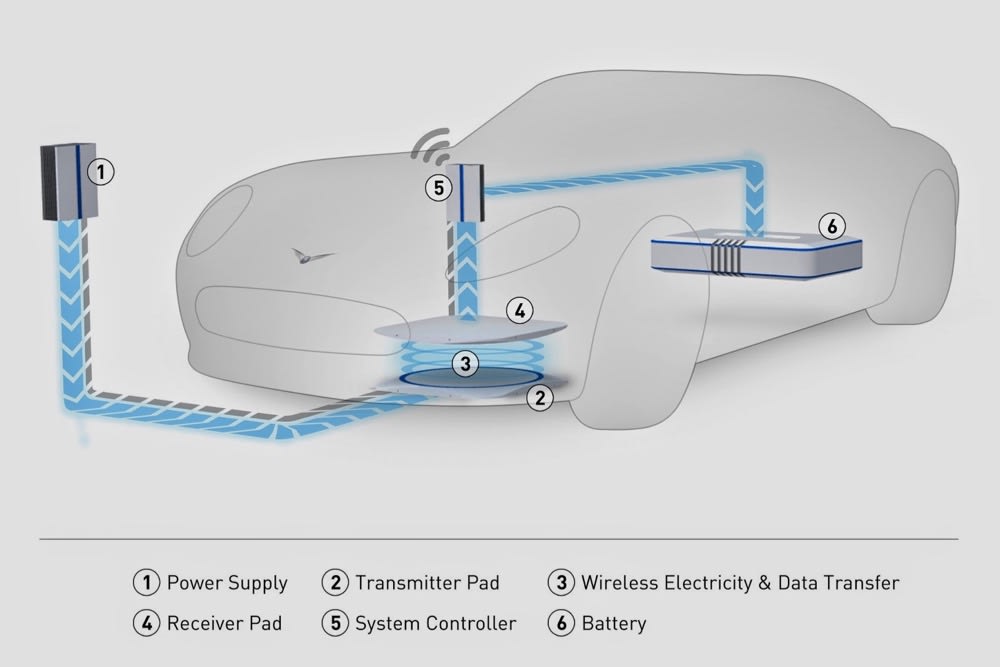

Electric vehicles (EV) gain their name from the electricity stored in their battery packs that power the car’s motor and turn the wheels. Hybrid vehicles also feature an electric battery, but they have a combustion engine contributing to motorized power too. Both these batteries can are rechargeable. The car plugs into wall sockets or specialized charging units and transports grid electricity to its internal battery. To understand how EV batteries work, this article will take a look at what car batteries are, the types of EV batteries, and how they charge to power electric cars.
What is a Battery?
Batteries store chemical energy and turn it into electricity. A battery contains a disproportionate number of negative to positive electrodes on either side of its construction. When connected by a type of cable, electrons from the negative half will flow to the positive side. This flow, popularized as electricity, can be harnessed to power different devices, such as lights, telephones, and even car motors. The force of electricity slows down over time as the electron numbers on each half balance out. At this point, the battery is considered dead because it can no longer produce electricity.
Various chemical reactions in batteries can create electricity, but automobile manufacturers have maintained an interest in the ones that can be recharged. Rechargeable batteries use electric energy to restart the flow of negative-to-positive electrons. Batteries with the right chemical properties to recharge are incredibly useful to cars because they don’t need constant replacement. For electric cars, three types of batteries work best in this process.
3 Types of EV Batteries:
1. Lead-Acid: Lead-acid batteries are the oldest form of rechargeable batteries — invented in 1859 — and have been used in both non-electric and electric cars. In these batteries, lead electrodes mix with acid to generate power. Since they’ve been around for so long, they are easy to work with, dependable, and inexpensive to make; however, they create potentially explosive gases when overcharged. They are used in nearly all conventional automobiles and as supplemental energy sources in some fully-electric and hybrid electric cars. Though some high-power ones are in development, lead-acid batteries perform poorly in cold temperatures and don’t last very long for EVs.
2. Nickel-Metal Hydride: Nickel-metal hydride batteries can pack a lot of energy into a relatively small package, giving them a high energy density. They are most common in hybrid-electric vehicles and recharge from the car’s fuel tank. They are extremely durable, safe, and produce little toxicity for optimal recycling. Unfortunately, they are expensive, have a low-energy density, and generate a lot of heat in high temperatures, making them poor choices for solely plug-in charging. Since hybrids feature both a combustion engine and the electric battery, they benefit the most from nickel-metal hydride batteries.
3. Lithium-Ion: Lightweight, low-maintenance, and high energy and high-temperature performance, lithium-ion batteries are the battery of choice in most electric vehicles. Lithium-ion batteries carry less weight and still hold great quantities of energy. Cars with them can travel farther on one charge and the battery has a low “self-discharge” rate, which means it can maintain a charge for an extended amount of time when not in use.
How does an EV Battery Charge?
In an EV, an electric traction motor replaces the traditional internal combustion engine in gasoline-powered cars. The EV uses a traction battery pack to store electricity later used by the motor to power the wheels. This battery pack requires recharging at plug-in stations, either at home or in public. Charging stations restart the chemical flow of negative-to-positive electrons. Overall vehicle driving range depends on the efficiency of the battery at using and storing electric energy.
In hybrids, the battery pack and electric motor are accompanied by a combustion engine that takes over as a power source when electricity is depleted. Plug-in hybrid batteries can also be recharged by plugging into charging ports or through regenerative braking. Both hybrids and fully-electric cars typically use an included plug-in cord to charge their similar batteries.
Charging an EV battery takes different amounts of time depending on charge level and car compatibility. For example, not all EVs can refuel their electricity stores from fast charging stations. Additionally, the range an EV battery can go off a single charge varies between battery types. Lead-acid electric batteries only provide about 80 miles, nickel-metal hydride 120 miles, and lithium-ion over 220 miles. While coming close, lithium-ion battery-powered EVs still fall short of gas-fed cars in their overall range. In comparison to gas stations, the gaps in available charging stations across the country contribute to this detriment.
How Long Do EV Batteries Last?
Due to the components used to create them, EV batteries can cost significantly more to replace than those in traditional cars. Luckily, most EV manufacturers supply warranties on their batteries should they expire before their time. Most last 5-8 years, or about 100,000 miles. Particularly lithium-ion, nearly all of an electric battery is recyclable, and some of its remaining charge can be returned to the electric grid as renewable energy and its metal parts repurposed.
Electric cars are becoming increasingly common as EV battery technology develops. More affordable and efficient all-electric vehicles are on the way. Just as lead-acid batteries became inexpensive and reliable after over a century of use and study, as will nickel-metal hydride and lithium-ion battery packs with more research, usage, and driving.



